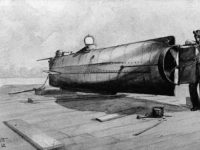In addition to Europe, the United States also developed the first submarines used for military purposes in the 19th century. One of the first and best-known was the CSS Hunley of the Confederate States, the first submarine in history to destroy an enemy ship.
Launching and design:
The experience of the American Civil War and the total inferiority of the Confederate Navy of the Northern Navy, prompted the naval leadership of the Southern States to resort to unconventional tactics.
For this reason, the marine engineer Horace Lawson Hunley developed some concepts for submarines, which should be used against the blockade of the warships of the northern states. The most famous boat of his is the CSS Hunley. This submarine let Hunley build with private funds in 1863 by the company Park and Lyons in Mobile / Alabama.
The boat was designed for a crew of nine men, one of which took over the control and the rest of the crew operated the hand crank for a wing propeller in the rear. The control itself was made by a rudder and a rudder. About two ballast tanks, one in the bow and one in the rear, which were filled and emptied by hand pumps, you could adjust the depth. The hand pumps were also used in an emergency to pump out penetrating water.
The outer shell was made of steel plates that were riveted to the construction. In order to achieve a lower flow resistance, the rivets were ground flush during construction.
Armament included only a lance about five meters long at the bow of the ship at the end of which was an explosive device. This lance was to be rammed by the submarine into the enemy ship and detonated when reversing the explosive device.
The launch took place in July 1863.
History of CSS Hunley:
After the launch some tests were done. On one of these test drives some of the crew members died. Hunley himself was then ordered by boat to Charleston to break the port blockade of the Northern Navy there with his submarine. After Hunley was still on some test drives, the boat was seized by the Navy.
On August 29, 1863, the first attack attempt was carried out on the ships of the northern states. In this case, the commander made a user error which led to the sinking of the submarine.
After salvaging and removing the bodies, the boat was made seaworthy again and Hunley himself took command. But also with him, the boat sank on October 15, 1863, where Hunley and seven crew members died.
Again, the boat was recovered and repaired to make the second attack attempt on the night of February 17, 1864. As target the USS Housatonic was selected. The second attack succeeded this time and the explosion caused the ship to sink. 5 crew members of Housatonic died, the rest could save themselves.
The end of CSS Hunley:
The Hunley attack on the USS Housatonic succeeded in the second attempt, but the submarine did not return to its port. Only on May 4, 1995, a search team succeeded in finding the wreck at a depth of 10 meters by using a magnetometer. The reason for the downfall and death of the crew is still not clear. Scientists believe that in the explosion of Housatonic the blast wave had also severely damaged the submarine and killed the crew.
Ship data:
| Ship type | Miniature submarine |
| Country | Confederacy |
| Launching | July 1863 |
| Whereabouts | Sunk on February 17, 1864 |
| Drive | Hand-operated propeller |
| Control | Depth and rudder, 2 ballast tanks |
| Length | 12 meters |
| Width | 1,17 meters |
| Displacement | 6,8 metric tons |
| Speed | 4 knots |
| Arming | 1 spear torpedo (lance with explosive device) |
| Crew | 7 to 9 men |
This post is also available in:
 Deutsch (German)
Deutsch (German)  Français (French)
Français (French)  Italiano (Italian)
Italiano (Italian)  简体中文 (Chinese (Simplified))
简体中文 (Chinese (Simplified))  Русский (Russian)
Русский (Russian)  Español (Spanish)
Español (Spanish)  العربية (Arabic)
العربية (Arabic)
















